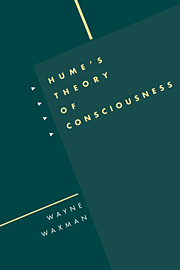Book contents
- Frontmatter
- Contents
- Preface
- Abbreviations
- Introduction: A false reason or none at all
- Part I The elements of Hume's philosophy
- 1 Impressions and ideas
- 2 Imagination and the vivacity of ideas
- 3 Words and measures
- Part II The cement of the universe
- Part III Vulgar fiction and philosophical fallacy
- Conclusion: The Cartesian nightmare come true
- Notes
- Bibliography
- Index
1 - Impressions and ideas
Published online by Cambridge University Press: 11 September 2009
- Frontmatter
- Contents
- Preface
- Abbreviations
- Introduction: A false reason or none at all
- Part I The elements of Hume's philosophy
- 1 Impressions and ideas
- 2 Imagination and the vivacity of ideas
- 3 Words and measures
- Part II The cement of the universe
- Part III Vulgar fiction and philosophical fallacy
- Conclusion: The Cartesian nightmare come true
- Notes
- Bibliography
- Index
Summary
Difficulties understanding “force and vivacity”
To comprehend the difference between impressions and ideas, it is crucial to distinguish those features of perceptions which are “immediately present to us by consciousness” (T212) from those that become evident only through experience and custom. For example, the supreme principle of Hume's theory of ideas – that every idea is copied from an antecedent impression – is experiential in nature. For the existential dependence of one perception on another, like any assertion of necessary connection, is a matter of experience: “the constant conjunction of our resembling perceptions, is a convincing proof, that the one are the causes of the other; and this priority of the impressions is an equal proof, that our impressions are the causes of our ideas, not our ideas of our impressions” (T5). The only elements of Hume's principle that are independent of experience (i.e. known by immediate perception) are the resemblance between impressions and ideas and the temporal precedence of one vis à vis the other (see T73 and T168f.); Yet, even these, as natural relations, are products of associative imagination (see T10ff.). So, the question is this: is there any immediately perceptible difference between impressions and ideas, prior to, and independent of, both experience and associative imagination, that warrants their distinction?
Hume's answer is that there is: we are immediately aware of a difference in force and vivacity among our perceptions.
- Type
- Chapter
- Information
- Hume's Theory of Consciousness , pp. 27 - 57Publisher: Cambridge University PressPrint publication year: 1994



